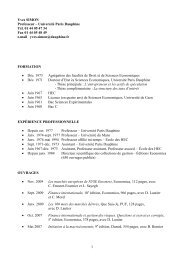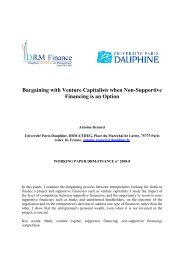Souad AJILI - CEREG - Université Paris-Dauphine
Souad AJILI - CEREG - Université Paris-Dauphine
Souad AJILI - CEREG - Université Paris-Dauphine
Create successful ePaper yourself
Turn your PDF publications into a flip-book with our unique Google optimized e-Paper software.
The Cross-Section Returns in France: Characteristics or Covariances<br />
For the dependent variable of our time-series regressions, we consider stock portfolio<br />
returns. Indeed, we regress monthly returns of the following portfolios: the six<br />
portfolios HS, HB, MS, MB, LS and LB, a portfolio with high B/M ratio (high B/M<br />
equity portfolio) which corresponds to the average of returns of two portfolios of high<br />
B/M ratio (HS and HB), or HB/M = (HS + HB)/2 and a portfolio with low B/M<br />
ratio (low B/M equity portfolio) which corresponds to the average of returns of two<br />
portfolios of low B/M ratio(LS and LB), or LB/M = (LS + LB)/2.<br />
Table 5 summarizes returns of the dependent and explanatory variables in the<br />
time series regressions. The average excess returns of the eight stock portfolios<br />
considered range from 0.83% to 1.33% per month. The positive relation between<br />
average returns and book to market equity is confirmed in the smallest size quintile<br />
because average returns increase with book to market ratio 12 . Like Molay (1999),<br />
in every book to market quintile but the medium, average returns tend to decrease<br />
with the size which confirms evidence that there is a negative relation between size<br />
and average return. All excess returns of portfolios have high standard deviations<br />
(greater than 6% per month). The low (high) book to market portfolio has an<br />
average annual return of 11.31% (14.10%). Fama and French (1998) 13 documented<br />
an annual excess returns of 9.46% and 17.10% for, respectively, low and high book<br />
to market portfolios in the case of France. All portfolios, but SL and BH (which<br />
have the smallest number of stocks), produce average excess returns that are more<br />
than two standard errors from zero.<br />
Table 5 shows also average values of explanatory variables. These values give<br />
the average risk premiums for the common factors in returns. The average value<br />
of excess returns of market portfolio is 1.045% per month with 2.932 t-statistic.<br />
This is large compared to Fama and French (1993) in the US-case (only 0.43% with<br />
1.76 standard errors from zero) and Molay (2001) in the French case (0.61% with<br />
1.36 standard errors from zero 14 . However, Fama and French (1998) documented<br />
an average annual value for the market portfolio in the French case about 11.26%<br />
(0.89% per month) and Heston et al. (1999) 15 about 1.21% per month. The average<br />
HML return is only 0.208% per month with a marginal 0.729 standard errors from<br />
zero. The size factor SMB produces an average premium of 0.103% per month,<br />
however the t-statistic is less than two (0.442).<br />
Because the size and the value premiums are relatively small, we can not produce a<br />
conclusive contest between the risk model and the characteristic model. In contrast,<br />
market premium allows more powerful tests of the two models.<br />
12 In a first publication on the French market (204 stocks) for the period from July 1992 to June<br />
1997, Molay (1999) confirms the negative relation between size and average return, however he<br />
does not found any relation between book to market ratio and average return. Standard deviation<br />
of excess stock portfolio returns in his study are less than these of our sample. In his thesis Molay<br />
(2001), he considered the period from July 1988 to June 1998 (120 months) for an average of 250<br />
stocks and he confirmed the negative size/average returns relation for only high book to market<br />
classes and the positive book to market/average returns relation for only small capitalisations.<br />
13 Fama and French (1998) study the case of France for the period from July 1975 to June 1995.<br />
There sample has, on average, 108 stocks<br />
14 Molay (1999) documented an average excess return for the market portfolio of only 0.31%.<br />
15 Heston et al. (1999) study the case of France (among 12 European countries) for the period<br />
from 1978 to 1995. There sample has 418 stocks<br />
11



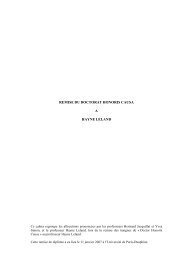

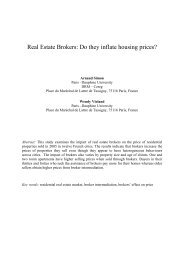
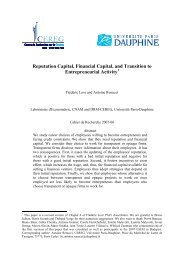

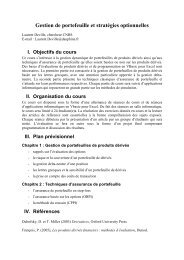

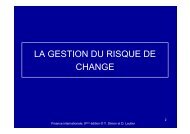
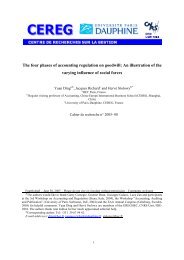
![& 6 ] ^ F ]^ - CEREG - Université Paris-Dauphine](https://img.yumpu.com/33326502/1/184x260/-6-f-cereg-universitac-paris-dauphine.jpg?quality=85)

